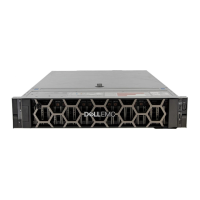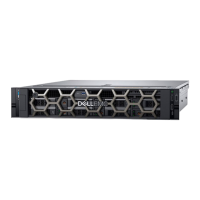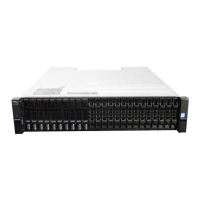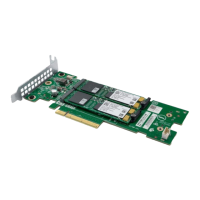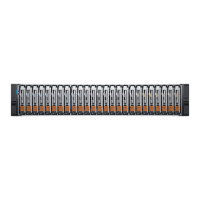c) Data host last (if powered down for maintenance purposes).
Allow time for each device to complete its Power On Self Tests (POST) before proceeding.
2. Perform a rescan to force a fresh discovery of all expansion enclosures connected to the controller enclosure. This step clears the
internal SAS layout information, reassigns enclosure IDs, and ensures the enclosures are displayed in the proper order. Use the CLI or
ME Storage Managerto perform the rescan:
To perform a rescan using the CLI, enter the following command: rescan
To perform a rescan using the ME Storage Manager:
a) Verify that both controllers are operating normally.
b) In the System topic, select Action > Rescan Disk Channels.
c) Select Rescan.
Using LEDs
This section describes the LEDs used to verify component operation. These LEDs are located on the enclosure front and rear panels.
Verify front panel LEDs
Front panel LEDs reside on the Ops panel located on the left ear flange. Disk LEDs are located on the carrier modules.
• Verify that the System Power On/Standby LED is illuminated green, and that the Module Fault LED is not illuminated.
• Verify that the enclosure ID LED located on the left ear is illuminated green.
• Verify that the disk module's LED is green or blinking green, and is not amber.
Verify rear panel LEDs
Rear panel LEDs are located on controller module, IOM, and PCM face plates.
• For controller modules and IOMs, verify that the OK LED is illuminated green, indicating that the module has completed initializing, and
is online.
• For PCMs, verify that the PCM OK LED is illuminated green on each PCM.
Using management interfaces
In addition to viewing LEDs as previously described, you can use management interfaces to monitor the health status of the system and its
components, provided you have configured and provisioned the system, and enabled event notification.
Select from the following methods to verify component operation:
• Use the ME Storage Manager to check the health icons/values of the system and its components, or to drill down to a problem
component. The ME Storage Manager uses health icons to show OK, Degraded, Fault, or Unknown status for the system and its
components. If you discover a problem component, follow the actions in its Recommendation field to resolve the problem.
• As an alternative to using the ME Storage Manager, you can run the show system command in the CLI to view the health of the
system and its components. If any component has a problem, the system health will be Degraded, Fault, or Unknown. If you
discover a problem component, follow the actions in its Health Recommendations field to resolve the problem.
• Monitor event notification — With event notification configured and enabled, you can view event logs to monitor the health of the
system and its components. If a message recommends that you check whether an event has been logged, or to view information
about an event in the log, you can do so using the ME Storage Manager or the CLI. Using the ME Storage Manager, view the event
log and then hover over the event message to see detail about that event. Using the CLI, run the show events detail command
with additional parameters to filter the output to see the detail for an event. See the CLI Reference Guide for more information about
command parameters and syntax.
Performing updates in MESM after replacing an
FC or SAS HBA
After replacing an FC or SAS HBA in an attached host, perform the following tasks:
1. For an FC HBA, update the zoning if a switch is used, then update the host/initiator grouping in MESM.
2. For a SAS HBA, update the host/initiator grouping in MESM.
For details about managing hosts and host groups in MESM, see the Administrator’s Guide.
Module removal and replacement
63

